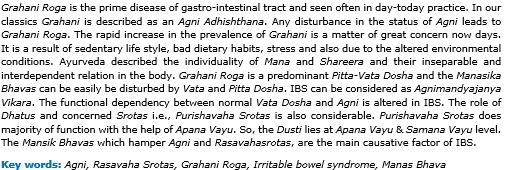Role of Manas Bhavas in Grahani Roga (Irritable Bowel Syndrome)
Keywords:
Agni, Rasavaha Srotas, Grahani Roga, Irritable bowel syndrome, Manas BhavaAbstract
Grahani Roga is the prime disease of gastro-intestinal tract and seen often in day-today practice. In our classics Grahani is described as an Agni Adhishthana. Any disturbance in the status of Agni leads to Grahani Roga. The rapid increase in the prevalence of Grahani is a matter of great concern now days. It is a result of sedentary life style, bad dietary habits, stress and also due to the altered environmental conditions. Ayurveda described the individuality of Mana and Shareera and their inseparable and interdependent relation in the body. Grahani Roga is a predominant Pitta-Vata Dosha and the Manasika Bhavas can be easily be disturbed by Vata and Pitta Dosha. IBS can be considered as Agnimandyajanya Vikara. The functional dependency between normal Vata Dosha and Agni is altered in IBS. The role of Dhatus and concerned Srotas i.e., Purishavaha Srotas is also considerable. Purishavaha Srotas does majority of function with the help of Apana Vayu. So, the Dusti lies at Apana Vayu & Samana Vayu level. The Mansik Bhavas which hamper Agni and Rasavahasrotas, are the main causative factor of IBS.
Downloads
References
Chakrapani. Commentator, Ayurveda Deepika Commentary, Agnivesha, Charaka Samhita, Sutrasthana: 1/54. In: Yadavji Trikamji, editor. Chaukhambha Sanskrit Sansthan, reprint, 2009, p. 16.
Anonymous: Shrimadbhagwadgeeta. 2/62-63, Gita press, Gorakhpur, UP, India
Vaidya Yadavji Trikamji, Charaka Samhita, Chikitsa Sthana(15/45-49) with the Ayurveda Dipika Commentory of Cakrapanidatta, Chaukambha Surbharati Prakashan, Varanasi, 1992; 152.
Pt. Hari Sadashiva Shastri Paradakar, Ashtanga Hridaya with the commentaries Sarvangasundara of Arundatta & Ayurvedarasayana of Hemadri, reprint ed. Varanasi: Chaukhamba Surbharati Prakashan; Nidana sthana, 2010; 12/1: 513.
Vaidya Yadavji Trikamji, Charaka Samhita Chikitsa Sthana(15/71) with the Ayurveda Dipika Commentory of Cakrapanidatta, Chaukambha Surbharati Prakashan, Varanasi, 1992; 152
https://jamanetwork.com/journals/jama/fullarticle/2174031
Chakrapani. Commentator, Ayurveda Deepika Commentary, Agnivesha,Charaka Samhita. In: Yadavji Trikamji, editor. Chaukhambha Sanskrit Sansthan, reprint, 2009, p. 323
Principles of internal medicine vol-2 harrisons’s 15 editition page no 1692
http://www.ncbi.nlm.nih.gov › articles › PMC4202343
Sir Stanley Davidson, Ed: Brian R Walker, Nicki R College, Stuart H Ralston, Ian D Penman. Davidson‟s principles and practice of medicine. Churchil livingstone, Elsevier. 22nd edition, 2014; 907.
Vaidya Yadavaji Trikamji Charaka Samhita elaborated by Charaka & Dridhabala with the Ayurveda dipika Commentary by Chakrapanidatta, reprint ed. Varanasi: Chaukhamba Surbharati Prakashan; Sutra sthana, 2011; 1/55: 15
Acharya Vaidya Yadavji Trikamji, Charaka Samhita, Chikitsa sthana-15, Chaukhamba Sanskrit Sansthan, Reprint, 2009; 323
Vaidya Yadavaji Trikamji, Charaka Samhita, elaborated by Charaka & Dridhabala with the Ayurveda dipika Commentary by Chakrapanidatta, reprint ed. Varanasi: Chaukhamba Surbharati Prakashan; Vimana sthana, 2011; 2/9: 238.
Sushruta: Sushruta Samhita with Nibandhasangraha Commentary of Shri Dalhanacharya & Nyayachandrika Panjika of Shri Gayadasacharya, edited by Vaidya Yadavaji Trikamji Acharya, reprint ed. Varanasi: Chaukhamba Surbharati Prakashan; Sutra sthana, 2012; 46/500: 251
Acharya Pandit Hemaraja Sharma, Kashyap samhita, Khilasthana-16/3-6, Chaukhambha Sanskrit Sansthan, Varanasi, Reprint, 2012; 335
S Liang X Wu, F Jin. Rethinking psychology from the micro biota gut brain axis. Frontiers in integrative neuroscience, 2018.
S Liang X Wu, F Jin. Rethinking psychology from the micro biota gut brain axis. Frontiers in integrative neuroscience, 2018.














